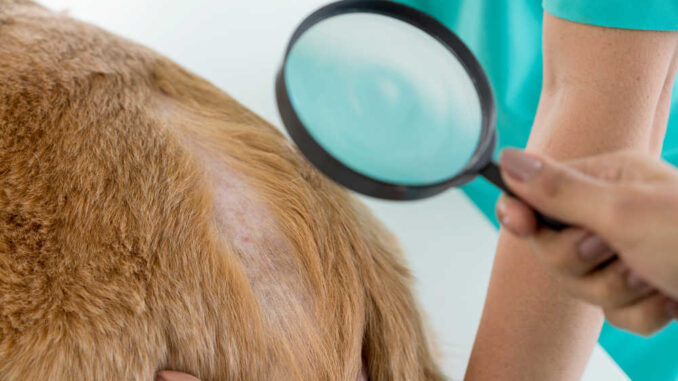
This article was updated on December 13th, 2023

As a veterinarian, I see dogs with dry or scabby skin on a weekly basis. It is a very common problem that many dog owners face which can lead to an unsightly coat and sometimes a very irritated dog! With many causes of dry or flaky skin in dogs, it can be confusing for owners to know where to start.
7 Things You Should Know About Dry Flaky Skin with Scabs in Dogs
In this article, I’ll highlight the most important things you should know and tips on how you can help your dog. Let’s get started!
1. Regularly groom your dog’s coat.
“Not regularly bathing or brushing your dogs coat can lead to dry flaky and even scabby skin. The skin naturally rejuvenates itself with time, and dead skin cells are pushed to the surface. If these aren’t brushed away then they can accumulate, giving the ‘dandruff’ look.”
Brushing your dog’s coat a few times per week will help remove dandruff and dirt from accumulating in their fur.
2. Ensure your dog is getting proper nutrition and enough water.
“A poor-quality diet or a lack of essential nutrients such as vitamins and Omega 3 can lead to a poor coat condition and flaky skin. Oils in the diet are essential in keeping the skin moistened. Without these, it can dry out, leading to soreness and scabbing.”
Omega-3 fatty acids, like this, may help improve the quality of your dog’s coat and skin barrier, preventing it from drying out and becoming flaky.
- HELPS THEM LOOK & FEEL GREAT, INSIDE & OUT: Pet Honesty’s Omega-3 Fish Oil for dogs & cats is a convenient way to add whole body support to their daily routine. Picky pets can put up a fight when it comes to adding new things to their diet, but this tasty oil is like the cherry on top that’s secretly healthy & beneficial to their overall well-being. The perfect blend of four types of wild-caught fish packed inside every bottle will have them feeling their best & begging for more.
Adequate hydration is also essential to the health of your dog’s skin and coat. Always make sure your dog has access to fresh water throughout the day.
3. Try home remedies to heal your dog’s dry skin.
If your dog’s dry, scaly skin with scabs is in its early stage, and your pet isn’t experiencing significant pain and discomfort, there are a variety of things you can try at home.
Here are a few home treatments I recommend:
Moisturizing Shampoos
There are a multitude of shampoo options in stores and online, such as this one:
- DID YOU KNOW WE USE NATURALLY DERIVED INGREDIENTS? Our dog coat shampoo formulas are made with 99.7% naturally derived ingredients including coconut oil, which provides a natural infusion of moisture to sooth dry dog coats
It’s important to avoid using shampoos labeled for treating certain conditions like fleas and ticks. Also, be careful not to bathe your dog too vigorously or too frequently, as this can strip the skin of natural oils and cause dry skin.
Coconut Oil
Applied in small amounts topically (to the surface of the skin), coconut oil, such as the product listed below this one may have moisturizing properties that can help alleviate dry skin:
- BALM FOR DOGS AND CATS: Organic Coconut oil for dogs, a soothing, natural treatment for dogs dry nose, elbows, ears, paws and wrinkles that heals and softens a pet's dry skin. As a dog ear cleaner or paw balm, coconut oil provides safe and highly effective itch relief for dogs. Great benefits for your feline friends too- all natural coconut oil is great for cats itchy skin, cracked paws and is effective in cleaning cat ears.
“Apply a small amount of coconut oil to your dog’s skin and massage it thoroughly. Please do not apply coconut oil to open wounds, do not apply copious amounts (your dog should not look greasy), and don’t feed coconut oil to your dog unless under the direction of your veterinarian.”
Use a Humidifier in your Home
Dry air can contribute to dry skin, especially in hot, dry summers or during winter when in-house heaters are naturally removing moisture from the air. Consider using a humidifier in your home, especially in areas where your dog frequently hangs out.
4. See a vet if your dog’s skin problems are persistent or if your dog shows signs of discomfort or illness
It is important to see a veterinarian if your dog has persistent scabs and dry skin for more than a few days or weeks despite the interventions listed above. You should also see a veterinarian as soon as possible if your dog shows any signs of discomfort or illness, such as itching or red skin.
These symptoms may indicate an underlying medical condition that requires veterinary treatment:
“While there are some remedies you can try at home for minor, superficial, new skin issues, ongoing skin problems or skin issues that are causing significant pain or discomfort should be seen by a veterinarian as soon as an appointment is available.”
Your pet needs a veterinarian’s expert care if you’ve noticed any of these signs:
- Severe itching or scratching (frequent or constant, maybe even enough to cause damage to the skin)
- Hair loss or bald patches
- Foul odor from the skin
- Redness or inflammation of the skin
- Discharge or pus from the affected area
- Changes in behavior, appetite, mood, or activity
If left untreated, or not properly treated, these scabs and dry skin can lead to more serious skin infections or other health issues.
5. The most likely causes include allergies, parasites, skin infections, and hormonal issues.
A veterinarian can perform a thorough examination and diagnostic tests to determine the underlying cause of the skin issues, which can be related to allergies, parasites, infection, or another medical condition.
Allergies
Dogs can be allergic to various things, just like humans. Food, pollen, insect or parasite bites, or even different materials or substances can cause an allergic reaction resulting in skin irritation, itching, and inflammation. This can then lead to flaky skin with scabs. Signs that you may have an allergic dog might be recurrent ear infections or anal gland issues, excessive paw licking or are constantly itchy “all over”.
Avoiding allergens is the most direct way to prevent allergic skin disease at home, but unfortunately, that’s not always possible. Therefore, you may need to work with your dog’s veterinarian to start medications, topical treatments, or even allergy shots. Fortunately, there are many treatment options that can keep your dog’s allergy signs under control and prevent uncomfortable skin signs.
Below are 2 examples of dry, flaky skin or scabs due to allergies:
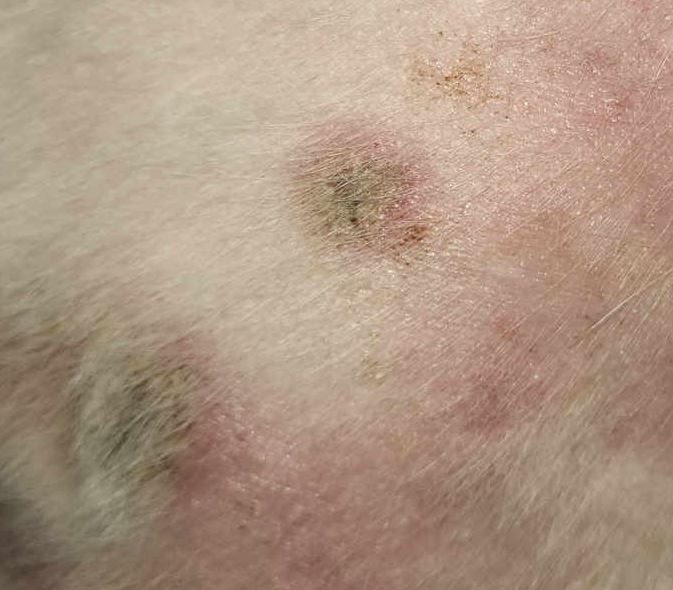
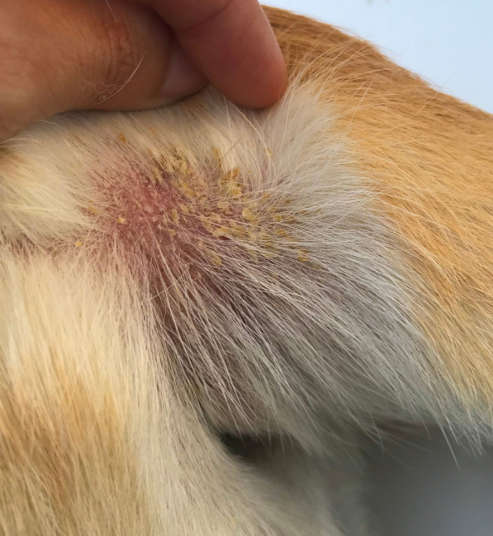
Parasites
Parasites on your dog’s skin, including fleas, ticks, and mites, can cause irritation that may lead to flaky skin and scabs. The area around a tick bite may become red, flaky, and form a scab. Flea infestations can cause localized skin reactions and swelling, sometimes eventually even hair loss and severe skin thickening. Many mites also result in flaking and scaley skin as they burrow under the skin surface, resulting in irritation and shedding of the outer layers of the skin.
Pictures of dry/flaky/red skin due to parasites:
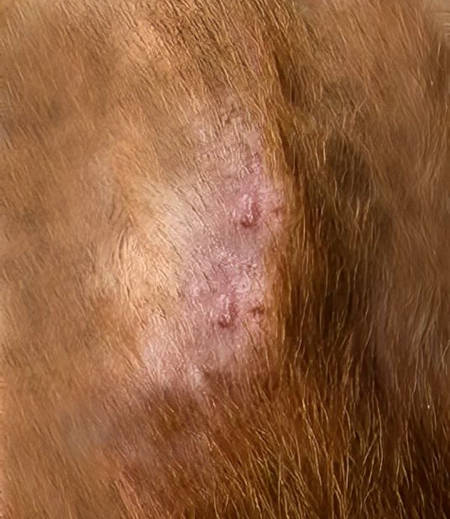
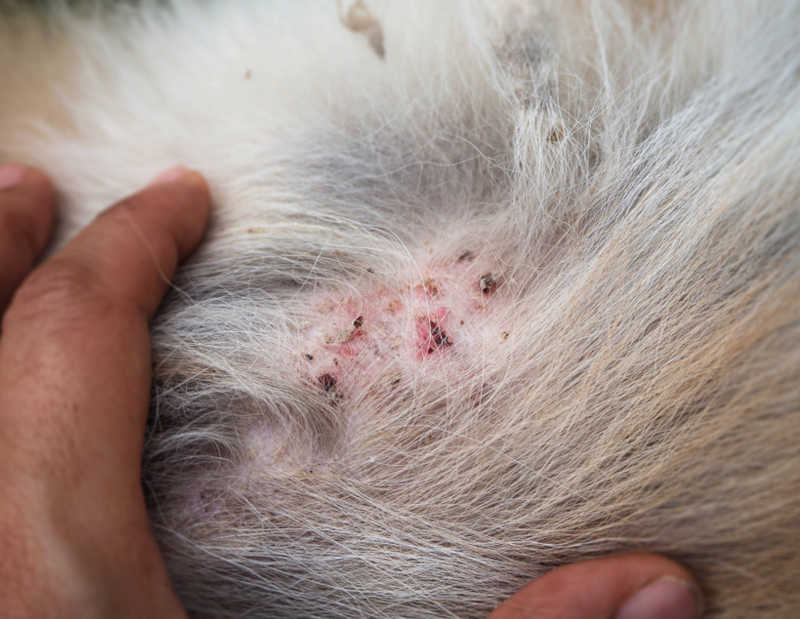
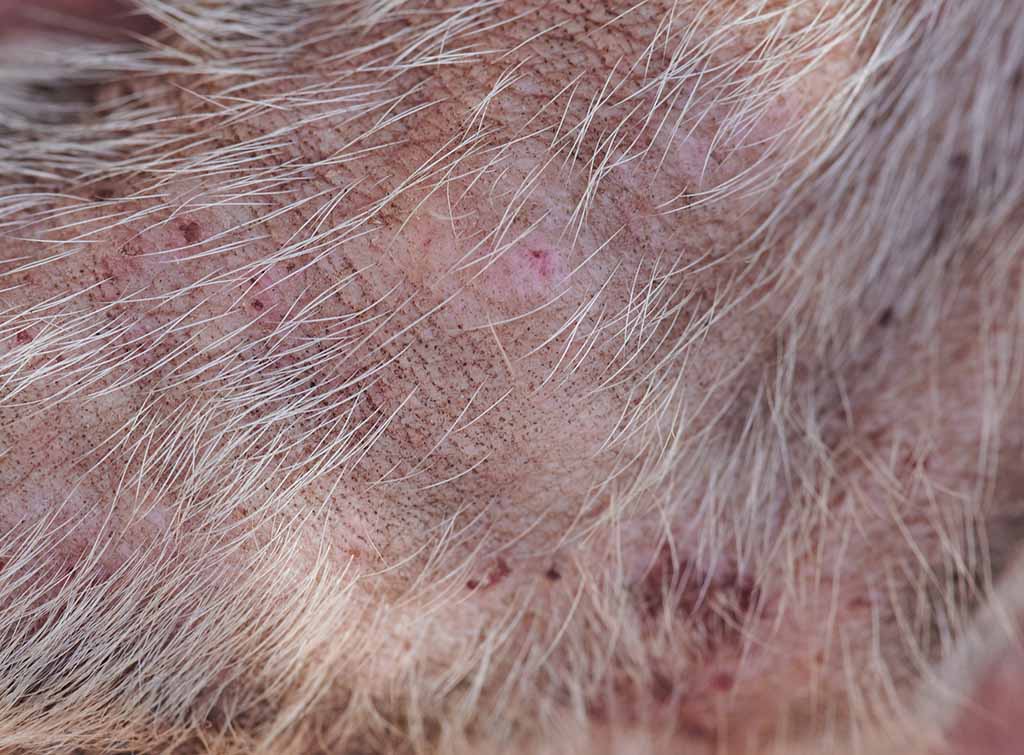
There are many flea and tick prevention options readily available to take care of a parasite problem at home. These can stop external parasite issues before they start, and they can even help if you’re managing a parasite problem after it’s begun. It’s best to go with a veterinary prescription product for this as many products available in superstores and pet shops are not effective enough.
If you think your dog is suffering from a parasite infestation, then talk to your vet. They’ll have many great options, not only to manage the parasites but also to treat the dry, flaky skin and scabs as your dog’s skin starts to heal again.
Skin infections
Bacterial or fungal skin infections (including ringworm) can cause skin inflammation, itching, and flaky skin with scabs. These infections can occur on their own or secondary to allergies or parasites, therefore it’s essential to talk to your veterinarian if you think your dog is suffering from these problems. You may notice excessive dampness, or even excessive dryness, in a patch of skin with an infection. Flakiness and scabbing are common, and often limited to a specific area, sometimes called a “hot spot”.
Pictures showing irritated, dry, flaky skin on dogs as a result of infections:
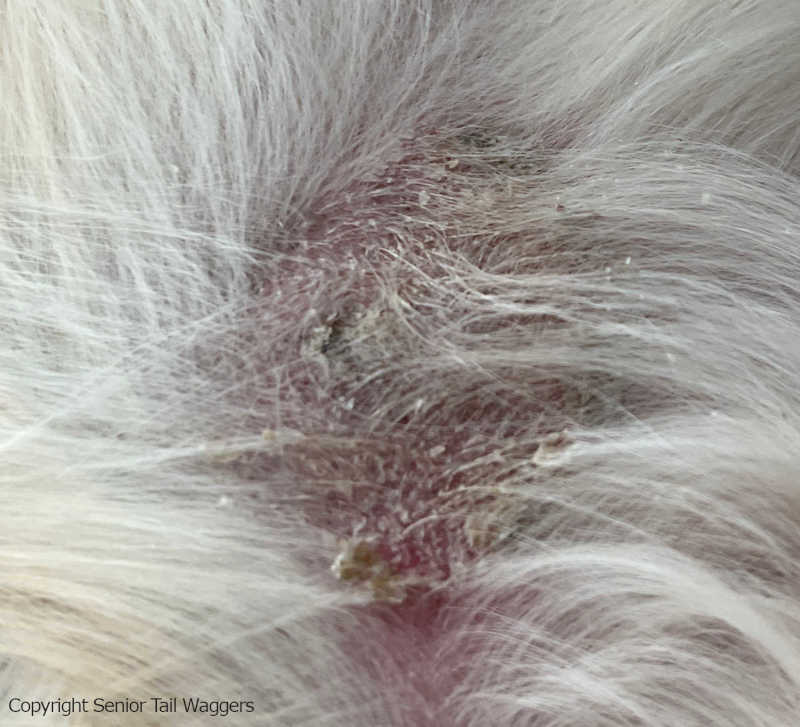
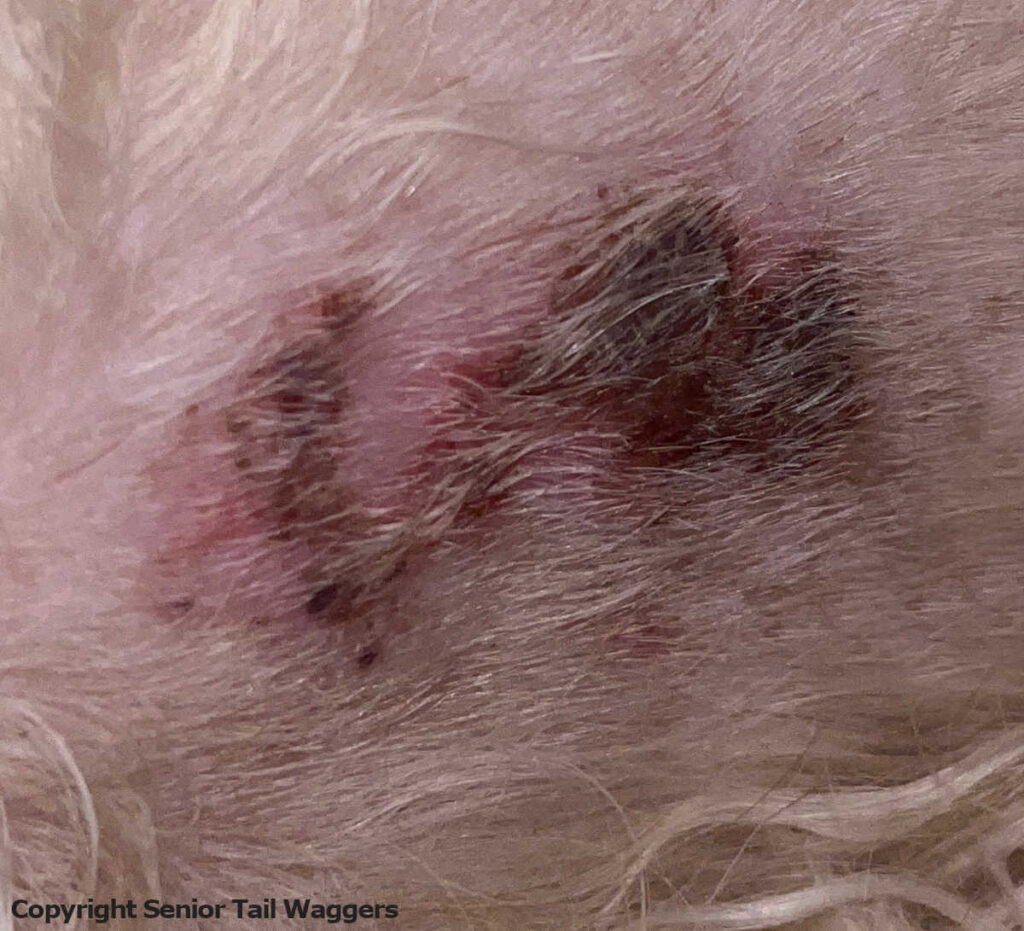
“Sometimes topical treatments or medicated baths are enough to treat infections and help your dog’s skin heal at home. But if the infected area is large or badly inflamed, specialized wound care (including shaving the fur in the area and treating with antiseptics), systemic antibiotics (an injection or oral medication provided by the veterinarian), antifungals (in the case of ringworm) and even steroids (if it’s bad enough) may be necessary.”
Swabs of the affected area may even need to be taken to identify the causative agent and to target the treatment effectively. These veterinarian-prescribed treatments are very effective when given as directed.
If the infection is secondary to an underlying condition then this will need to be addressed as well in order to successfully treat the infection.
Hormonal imbalances/endocrine disorders
Some hormonal imbalances, such as hypothyroidism or Cushing’s disease, can affect skin health and lead to flaky skin with scabs.
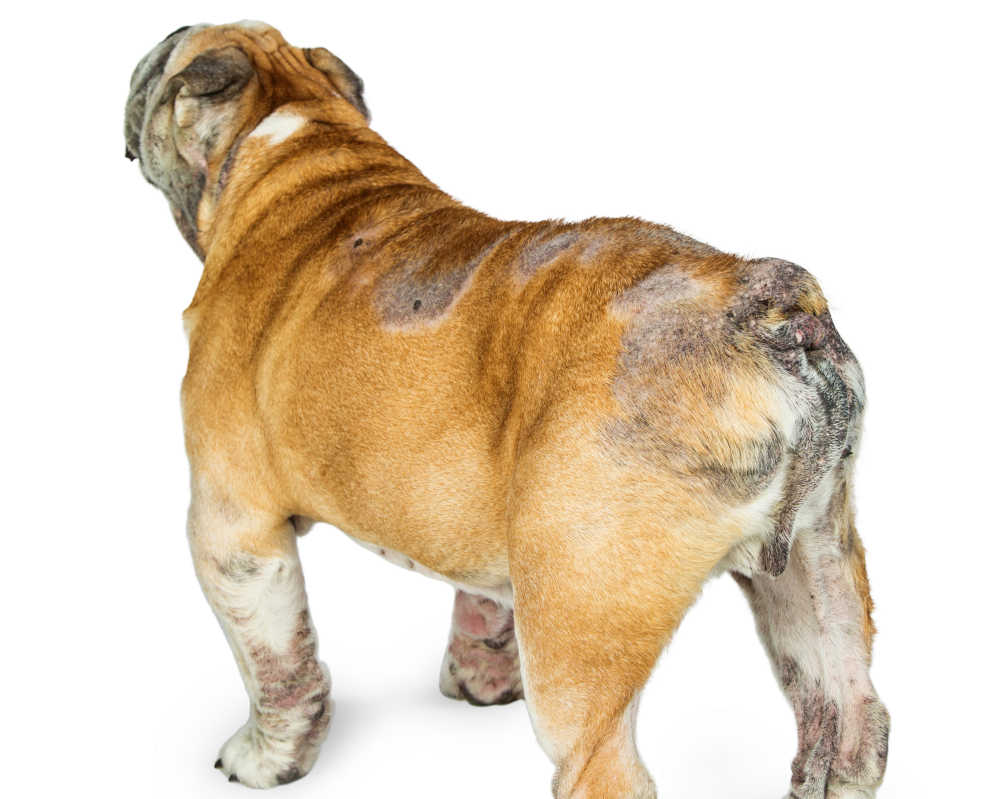
In the picture below, a Yorker mix has dry and flaky skin in places with some darkening of the skin (hyperpigmentation) due to Cushing’s disease. On his belly, there are some raised plaques, and his skin also looks a little red and inflamed:
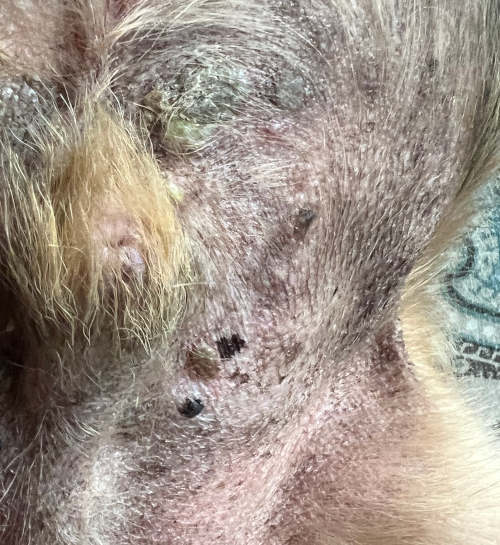
In the case of hormonal imbalances, these are conditions that need to be addressed and treated with the help of your veterinarian; diagnostic tests are required to figure out what disorder they need to treat. Various hormone-regulating drugs can be administered to try and correct the imbalance once a diagnosis has been made.
In addition to treating the hormonal issue, your veterinarian may prescribe other treatments that will treat the skin condition separately while addressing the hormonal issue. Treating the dry, flaky skin condition often includes supplements containing omega-3 fatty acids, topical medications that promote skin health, or other medications to reduce inflammation.
Other causes of dry, flaky skin and scabs in dogs
Other medical conditions, such as autoimmune disorders, cancer, or kidney disease, can also affect skin health and lead to flaky skin with scabs. Each of these conditions carries its own set of unique signs, and they each are treated differently. If attempts to treat dry, flaky skin with scabs at home prove ineffective, and your veterinarian has ruled out other causes, they may recommend additional testing to decide if another medical condition is to blame.
Diagnosis
A physical exam, along with a thorough medical history, is a veterinarian’s first step to diagnose your dog’s scabs and dry skin. Be sure to share all relevant information you can when you make your pet’s appointment and again at the appointment when they’re asking questions.
Most veterinarians are going to ask you the same kind of questions when it comes to your pet’s skin issue:
- When did you first notice the problem?
- Is your dog still eating/ drinking/ acting the way they always have?
- How often is your dog scratching or biting at the area you’re concerned about? Have you noticed them scratching or biting other areas, too?
- How much has the affected area changed since you first saw a problem?
- Are there any new cleaning products, shampoos, foods/ treats, medications, human food, etc., that your pet has been exposed to?
- What kind of parasite prevention are they on?
- Do you notice issues are worse after your dog has been somewhere specific- like a bedroom, your laundry room, or outside?
- Does your dog have a history of skin issues, allergies, or other medical conditions?
- Is there anything that makes your dog’s dry, flaky, and scabbed skin improve noticeably?
It might seem like a lot of questions, but these can all help your veterinarian form initial opinions about the cause of your dog’s condition. The more relevant information you can share, the closer your vet will be to understanding how to help your pet.
During the physical exam, the vet will look at your dog’s skin, coat, and overall appearance. They may also take a sample of your dog’s skin to examine under a microscope or perform skin scrapings to look for parasites or fungal infections. Depending on the physical exam and any initial testing, blood tests and allergy testing may also be necessary to help diagnose the cause of your dog’s skin issues.
Once the cause of your dog’s skin issue has been determined, you can expect a customized treatment plan that might include medications, supplements, or other therapies.
6. Avoid irritants.
Be mindful of any potential irritants that may be contributing to your dog’s skin issues, such as harsh chemicals in cleaning products or allergens in the environment.
For instance, if your dog likes to sleep on the kitchen floor, avoid using strong cleaners or lay down a blanket so your dog doesn’t have direct exposure. Reduce the use of air fresheners, carpet fresheners, and other chemicals that you wouldn’t feel comfortable walking barefoot on or sprinkling in your own bed.
7. Treatment can take a few weeks or months to be effective.
Once a veterinarian determines the cause of your dog’s dry, flaky skin, treatment may include a combination of topical medications and shampoos, dietary supplements, medication, and lifestyle changes. These treatments will help to soothe the skin and reduce inflammation while also helping to heal scabbed areas. In some cases, anti-allergy or antibiotic medications may be required to help reduce the symptoms of dry, flaky skin in your pet.
“Recovery from dry flaky skin can take some time, usually a few weeks or months depending on the severity. If your pet is suffering from an underlying condition such as allergies, appropriate management and lifestyle changes may be necessary for long term relief.”
It is important to monitor your dog’s skin and coat regularly to ensure there is no reoccurrence of the problem. Regular visits to the veterinarian during treatment will ensure that your pet is on the road to recovery.
Typical Veterinary Costs of Treating Scabs and Skin Infections in Dogs
The typical costs of treating scabs and skin infections in dogs can range from $50 to $150, depending on the severity of the condition. It’s important to note that some more complicated issues, such as ongoing allergies or underlying skin cancers that require more advanced treatments are more expensive to treat.
Dry, flaky skin with scabs in dogs: what does it look like?
The actual look of dry, flaky skin with scabs can vary, depending on the cause. Commonly, this condition will cause a dog’s fur to become dull and brittle with flakes of skin that have either fallen off or are still attached to their coat.
Some areas may become irritated and scaly, and you might even see open sores or scabs often as a result of signs of discomfort like scratching or chewing. Hair loss is also common in these affected areas of skin.
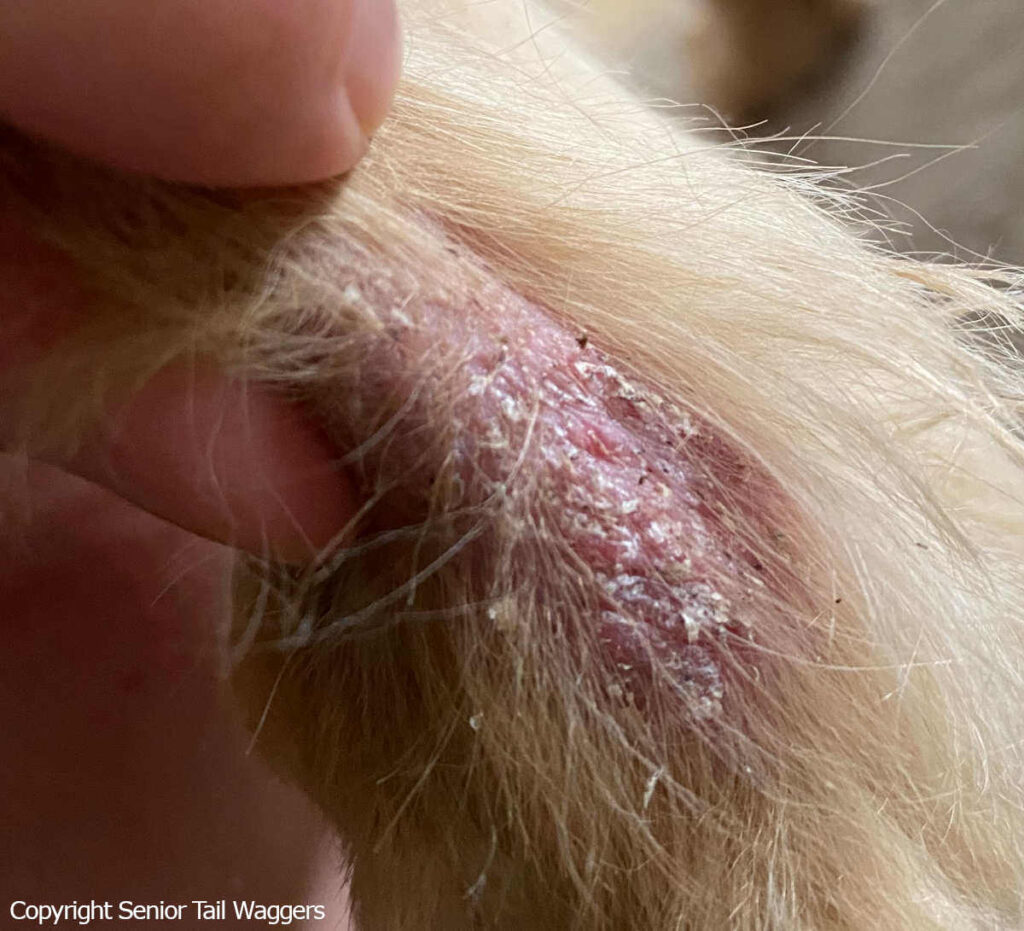
Dry flaky skin might look like small white or gray flecks on your dog’s skin or fur. These may be more noticeable in areas with less hair or where the skin is darker, such as the belly, groin, or armpits. You might even think it looks similar to dandruff in humans!
Scabs may also be present on areas of irritated skin. A scab is a protective crust or clot that forms over a wound or abrasion on the skin. As the damage to the skin begins to heal, a scab forms over the area to protect it from further injury and infection.
Disclaimer: This website's content is not a substitute for veterinary care. Always consult with your veterinarian for healthcare decisions. Read More.








Be the first to comment